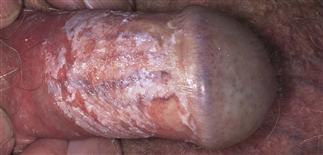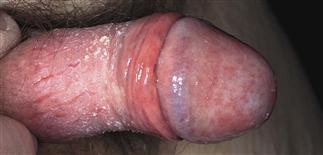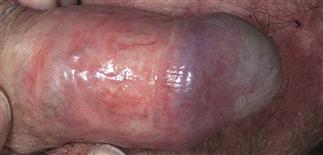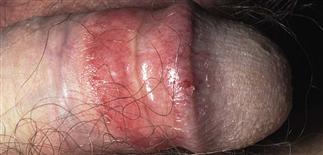68
Candidal balanitis

Classic presentation. White exudate forms in the intertriginous spaces created by the foreskin covering the shaft of the penis. The glans shows no sign of infection.

Infection present for weeks. Highly characteristic red papules and pustules present on glans. White exudate covers the inflamed shaft. Painful fissures occurred after repeated retraction of foreskin.

Chronic Candida infections may present with just tenderness and dry, red, inflamed skin. The characteristic white exudate may never appear. The skin becomes fragile and sore.

This patient is circumcised but obese. An intertriginous area was created by a skin fold; the yeast thrived in the warm, moist space. Cool compresses and ketoconazole cream were effective.
DESCRIPTION
An acute and chronic infection of the foreskin and glans penis caused by Candida organisms.
HISTORY
• Occurs more frequently in uncircumcised men. • Intercourse with an infected woman is a potential risk factor. Infections also occur without sexual exposure. Obesity and diabetes are risk factors. Any circumstance that encourages warmth and moisture predisposes to infection. • Itching and pain vary from mild to moderate; many cases are asymptomatic. • Infection may recur. • Patients with psoriasis may have a red inflamed penile shaft and glans that appear to be infected with yeast.
PHYSICAL FINDINGS
• Yeast invades the superficial epidermis, producing pustules and exudate. Acute infections start with tender, pinpoint, red papules and pustules that appear on glans and shaft. Pustules rupture under the foreskin and are usually never seen. White, thick, creamy exudate similar to that seen in Candida vaginal infections may be present. Ulceration and fissures follow if the infection persists. • Edema and pain can be intense enough to limit retraction of the foreskin. Some patients with chronic Candida infections have no exudate; rather, the shaft is sore and fragile. • Potassium hydroxide examination reveals numerous yeast forms. Culture of acute exudate shows Candida species. Bacterial culture may reveal coexistent bacterial infection.
TREATMENT
• Many antifungal creams rapidly effective. Apply miconazole, clotrimazole, ketoconazole, oxiconazole, or econazole cream twice daily for 7 days. Avoid topical steroids or combination steroid-antifungal creams. • A single 150-mg dose of fluconazole is as effective as clotrimazole cream applied topically for 7 days. Itraconazole 200 mg q.d. for 3–5 days also effective. • Consider circumcision in chronic or recurrent cases.







